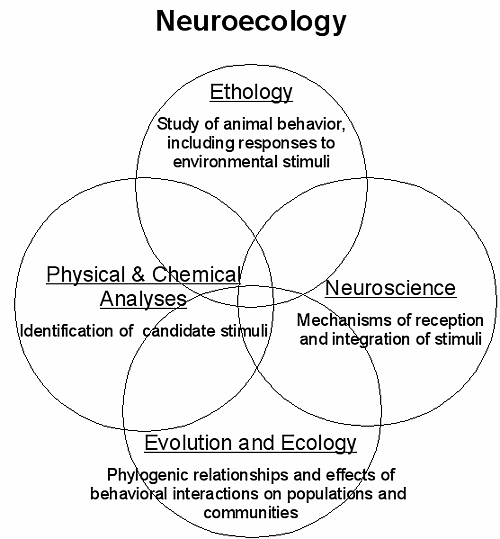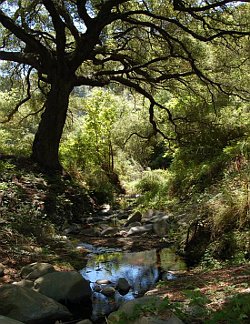SICB Annual Meeting 2011
January 3-7, 2011
Salt Lake City, UT
Symposium: Neuroecology: Neural Determinants of Ecological Processes from Individuals to Ecosystems
I. Symposium Overview

Behavior is controlled by nervous systems through processes that are sculpted by evolution through natural selection. The outcomes of behavioral encounters in turn often have profound consequences on populations and communities. Neuroecology synthesizes the neuroethological and ecological principles underlying these interactions, embodying both the neural basis for behavior and the role of behavior in establishing patterns of organism abundances, species distributions, and rates of material and energy flow within natural habitats. A conceptualization of the neuroecological approach to the study of chemical ecology is presented as a Venn diagram in Figure 1. Diverse disciplines make important contributions to this approach. Your browser may not support display of this image. Measurement of the physical and chemical worlds in which organisms live identifies which stimuli may be involved in interactions. Ethology allows evaluation of the behavioral relevance of these stimuli. Neuroscience determines what stimuli are detected and the molecular, cellular, and systems level mechanisms underlying their reception and integration. Neuroethology combines neuroscience and ethology to yield neural explanations to animal behavior. Sensory ecology uses neuroethological approaches with the additional focus on the realistic sensory information that organisms obtain from their environments. Evolutionary approaches allow investigations of phylogenetic relationships and how the habitat in which organisms live can influence the nature of their chemical senses. Ecological approaches can show how behavioral interactions shape the dynamics and structure of communities and even ecosystems. Reliance upon only one of these approaches yields only partial understandings of a system. The neuroecological approach, which is inclusive of the intersections of these disciplines, yields a more complete understanding at all levels.
II. Sponsors
SICB Divisions: DNB, DEE, DAB
American Microscopical Society
Marine Biological Laboratory
The Biological Bulletin
National Science Foundation
III. Symposium Objectives
Our symposium will attempt to integrate observational and experimental approaches, with the aim of yielding a new, emergent view that is otherwise impossible from isolated physiological, behavioral, or ecological components. Our aim is to improve basic understanding of native environments and sensory cues, and their impacts on biological responses at individual, population and community levels of organization.
 IV. Symposium Organizers
IV. Symposium Organizers
S4.0 Wednesday, Jan. 5, 07:45 Derby, C.; Zimmer, R.:
Introduction
S4.1 Wednesday, Jan. 5, 08:00 ZIMMER, Richard:
The ‘Neuroecology’ of Sperm-Egg Interactions
S4.2 Wednesday, Jan. 5, 08:30 RYAN, MJ:
Perceptual Biology and Social Ecology
S4.3 Wednesday, Jan. 5, 09:00 TRICAS, T.C.:
Variation, Selection, and Ecological Constraints in the Sensory-Motor Systems of Fishes
S4.4 Wednesday, Jan. 5, 10:00 DERBY, Charles:
The Neuroecology of Chemical Defenses
S4.5 Wednesday, Jan. 5, 10:30 RIFFELL, Jeffrey A.:
Neural basis of a pollinator’s buffet: olfactory specialization and learning in the Manduca sexta moth
S4.6 Wednesday, Jan. 5, 11:00 APPEL , H.M.:
Behavioral Ecology of Chemical Communication in Plants
S4.7 Wednesday, Jan. 5, 11:30 STEINBERG, PD:
Integrating the “neuroecology” of bacteria and eukaryotes
S4.8 Wednesday, Jan. 5, 13:00 BUSKEY, E.J.*; LENZ, P.H.; HARTLINE, D.K.; GEMMELL, B.; BRADLEY, C.; SHENG, J.; STRICKLER, J.R.:
Sensory perception, behavioral adaptations and the neuroecology of predator avoidance in planktonic copepods
S4.9 Wednesday, Jan. 5, 13:30 GRETHER, Greg:
The neuroecology of competitor recognition
S4.10 Wednesday, Jan. 5, 14:00 NEVITT, Gabrielle:
Global climate regulators as info-chemicals: Stories from birds and fishes”
S4.11 Wednesday, Jan. 5, 14:30 LEIS, J.M.*; SIEBECK, U.; DIXSON, D.L.:
How Nemo finds home: neuroecology of larva dispersal and population connectivity in marine, demersal fishes

